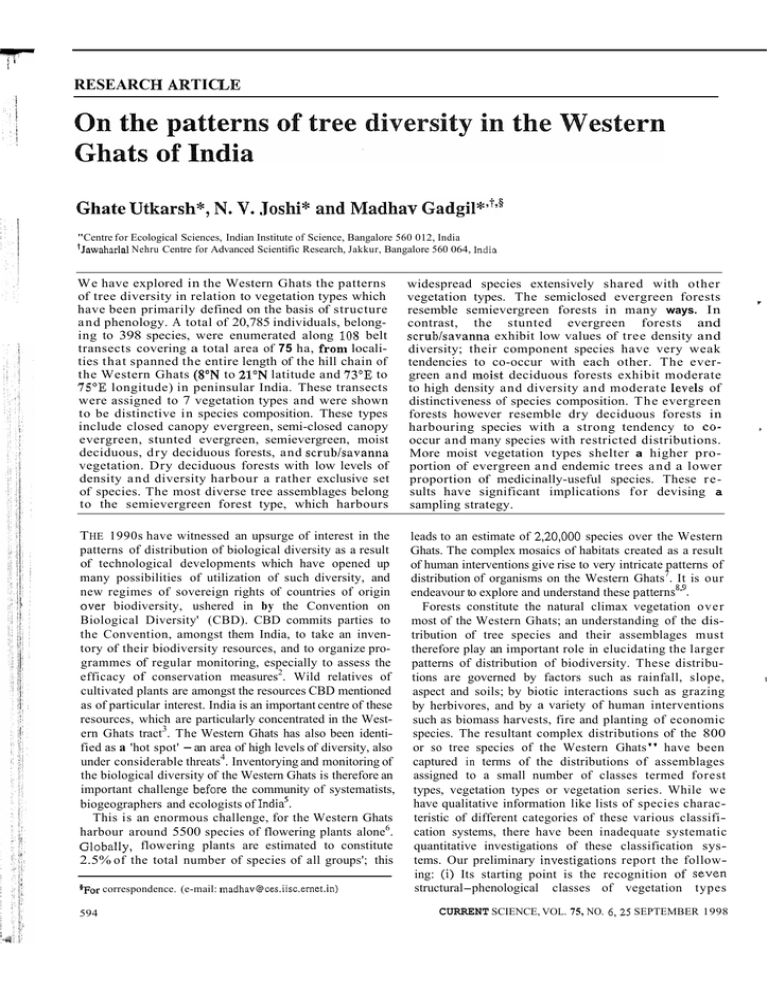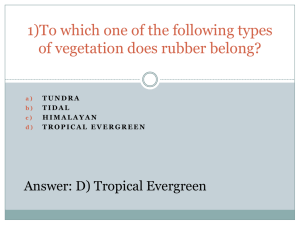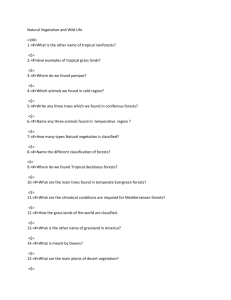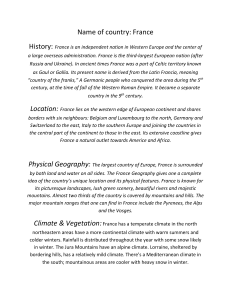v hate Utkarsh*, f
advertisement

4m f RESEARC TIC hate Utkarsh*, v "Centre for Ecological Sciences, Indian Institute of Science, Bangalore 560 012, India ?Jawaharlal Nehru Centre for Advanced Scientific Research, Jakkur, Bangalore 560 064, India We have explored in the Western Ghats the patterns of tree diversity in relation to vegetation types which have been primarily defined on the basis of structure and phenology. A total of 20,785 individuals, belonging to 398 species, were enumerated along 108 belt transects covering a total area of 75 ha, from localities that spanned the entire length of the hill chain of the Western Ghats (SON to ZION latitude and 73"E to 75"E longitude) in peninsular India. These transects were assigned to 7 vegetation types and were shown to be distinctive in species composition. These types include closed canopy evergreen, semi-closed canopy evergreen, stunted evergreen, semievergreen, moist deciduous, dry deciduous forests, and scrubhavanna vegetation. Dry deciduous forests with low levels of density and diversity harbour a rather exclusive set of species. The most diverse tree assemblages belong to the semievergreen forest type, which harbours widespread species extensively shared with other vegetation types. The semiclosed evergreen forests resemble semievergreen forests in many ways. In contrast, the stunted evergreen forests and scrub/savanna exhibit low values of tree density and diversity; their component species have very weak tendencies to co-occur with each other. The evergreen and moist deciduous forests exhibit moderate to high density and diversity and moderate levels of distinctiveness of species composition. The evergreen forests however resemble dry deciduous forests in harbouring species with a strong tendency to cooccur and many species with restricted distributions. More moist vegetation types shelter a higher proportion of evergreen and endemic trees and a lower proportion of medicinally-useful species. These results have significant implications for devising a sampling strategy. THE 1990s have witnessed an upsurge of interest in the patterns of distribution of biological diversity as a result of technological developments which have opened up many possibilities of utilization of such diversity, and new regimes of sovereign rights of countries of origin Over biodiversity, ushered in by the Convention on Biological Diversity' (CBD). CBD commits parties to the Convention, amongst them India, to take an inventory of their biodiversity resources, and to organize programmes of regular monitoring, especially to assess the efficacy of conservation measures2. Wild relatives of cultivated plants are amongst the resources CBD mentioned as of particular interest. India is an important centre of these resources, which are particularly concentrated in the Western Ghats tract3. The Western Ghats has also been identified as a 'hot spot' - an area of high levels of diversity, also under considerable threats4. Inventorying and monitoring of the biological diversity of the Western Ghats is therefore an important challenge be€ore the community of systematists, biogeographers and ecologists of India5. This is an enormous challenge, for the Western Ghats harbour around 5500 species of flowering plants alone6. Globally, flowering plants are estimated to constitute 2.5% of the total number of species of all groups'; this leads to an estimate of 2,20,000 species over the Western Ghats. The complex mosaics of habitats created as a result of human interventions give rise to very intricate patterns of distribution of organisms on the Western Ghats7. It is our endeavour to explore and understand these patternsspg. Forests constitute the natural climax vegetation over most of the Western Ghats; an understanding of the distribution of tree species and their assemblages must therefore play an important role in elucidating the larger patterns of distribution of biodiversity. These distributions are governed by factors such as rainfall, slope, aspect and soils; by biotic interactions such as grazing by herbivores, and by a variety of human interventions such as biomass harvests, fire and planting of economic species. The resultant complex distributions of the 800 or so tree species of the Western Ghats" have been captured in terms of the distributions of assemblages assigned to a small number of classes termed forest types, vegetation types or vegetation series. While we have qualitative information like lists of species characteristic of different categories of these various classification systems, there have been inadequate systematic quantitative investigations of these classification systems. Our preliminary investigations report the following: (i) Its starting point is the recognition of seven structural-phenological classes of vegetation types &Forcorrespondence. (e-mail: inadhav@ces.iisc.ernet.in) 594 CURRENT SCIENCE, VOL. 75, NO. 6 , 2 5 SEPTEMBER 1998 r P f RESEARCH ARTICLE largely following the French Institute", Indian Forestry Research" and UNESC013 systems. (ii) The extent to which classes recognized on the basis of structure and phenology vary in terms of species composition. Specifically we are interested in the variation in species composition amongst different samples assigned to the same class, in contrast to different classes. (iii) Levels of a- and P-diversity in samples from the various classes. (iv) Apart from these attributes of individual or pairs of assemblages we are interested in other attributes which can be computed from larger sets of assemblages. These include measures of how prevalent species making up an assemblage are and the extent to which they occur together. (v) We have introduced some new ways of looking at these issues and apply them to the tree assemblages of the Western Ghats. Materials and methods Western Ghats, the focus of our studies, comprise 0f.a chain of hills 1600 km in length running parallel to the west coast of the Indian peninsula, with a width from 5 km to 150 km and elevations rising up to 2800 m (ref. 6). The higher elevations support a restricted number of vegetation types; the great majority of types being extensively distributed at lower elevations". Western Ghats supports an elaborate rnosaic of vegetation types, and our samples are based on 108 transects each confined to a relatively homogeneous patch of a single vegetation type at 30 localities with elevations ranging from sea level to 1200 m. For our purpose we distinguish 7 vegetation types on the basis of structure - physiognomic and phenological attributes. Table 1 specifies their correspondence with the typologies suggested by Champion and Seth12,Pascal" and UNESCO'3. Champion and SethI2 provide a structuralphenological classification framework, but neglect the more human impacted vegetation types, and consider some of the vegetation types as belonging to subtropical climatic zone, a view which is no longer widely held14. Within this framework, Pascall' has carefully identified various human impacted categories, and we use some of them. However, within each structural category he proposes several geographically separated series of plant communities, identified on the basis of dominant species of the potential climax. We have not adopted such a fine classification as the species composition changes more or less continuously even in adjacent localities within a given structural type. Further, as potential climax forests are restricted to a very small area, it is best to design a practicable system to classify the vegetation that exists, as permitted by the prevalent levels of human influence, all over the Western Ghats. The typology we propose is as follows: 1) Evergreen forests comprise tall trees (25-30 m in height), with erect, closed, dense canopy covering CURRENT SCIENCE, VOL. 75, NO. 6,25 SEPTEMBER 1998 nearly 95% of the ground (by canopy we mean overall vegetal cover, not just the top canopy). Due to the gaps in the top canopy that occupy up to 10% of the forest area, complete canopy closure is not possible. Nearly all - 90% or more trees belong to evergreen species. Leaves are thick, dark or blackish green and shining. Barks of many trees are smooth. Many trees have large buttresses. Lianas, i.e. woody climbers are not uncommon. Undergrowth is almost devoid of herb species. Thorny species are few, mainly canes and pandanus, which are common. 2) Semiclosed evergreen forests have tall trees (2025 m in height), and partially closed (80-95%) canopy. 80% to 95% trees belong to evergreen species. Although the canopy is much more closed than in the case of semievergreen or deciduous forests, we have used the term semiclosed only to distinguish these from highly closed canopy evergreen forests. Because of the canopy openings in the past, a few herbaceous species and many pioneer woody species, including some deciduous ones, inhabit the forest floor. Lianas, especially canes, are common. Thorny species, including canes, are not uncommon. 3) Stunted evergreen forests have dwarf trees, 1015 rn in height with a closed (80-95%) canopy. Over 80% of the trees are evergreen. The trees often branch at the base and have a spreading canopy. Buttressed trees are rare or absent. Lianas are very abundant. The forests are rich in undergrowth of pioneer shrubs like Strobilanthes, which have thin, hairy leaves. Thorny species are not uncommon, but canes and pandanus are rarely present. 4) Semievergreen forests have a mixture of moderately tall evergreen and deciduous trees, 15-20 m in height, and closed (60-80%), dense canopy. About 4080% trees are evergreen. Unlike the closed and semiclosed evergreen forests, many trees lack straight, tall boles and have an irregular canopy. Herbaceous species are not uncommon on the forest floor and climbers grow in profusion. Lianas are common. Canes are uncommon and pandanus rare. . 5 ) Moist deciduous forests have moderate, tall trees (10-20 m in height), and closed but not very dense canopy (40-70%). 0 to 40% trees are evergreen. The deciduous species tend to shed their leaves early, around January. Trees have rough bark; mostly thin, pale green leaves. Buttressed stems are rare. Undergrowth contains many herbaceous species. Occasionally, there is extensive growth of weeds like Lantana or Eupatoriunz. Lianas are very few, but climbers are common. Thorny species are not uncommon, but canes and pandanus are not present. 6) Dry deciduous forests have tall trees of 10-15 ni in height with a rather open (40-60%) canopy. Evergreen and buttressed trees are not present. Lianas are rare. Thorny species are common, but canes and pandanus are 595 RESEARCH ARTICLE Table 1. The correspondence between vegetation types amongst various classification systems Proposed type Champion and Seth12 Pascal" UNESC0I3 ~- ~ Evergreen forests West coast tropical evergreen forests, 1.A.C4 Lowland wet climax evergreen forests Tropical lowland broadleaved seasonal evergreen forests, I.A.2.a. 1 Semi-closed evergreen forests Same as above Disturbed lowland wet evergreen forests Same as above Stunted evergreen forests Western subtropical broadleaved hill forests, 8.A. C.2 Stunted submontane evergreen forests Tropical broadleaved seasonal evergreen submontane/cloud forests, I.A.2.e. 1 Semievergreen forests West coast tropical semievergreen forests, 2.A.C.2 Secondary semievergreen forests Tropical lowland broadleaved semideciduous forests, I.A.3.a.1 Moist deciduous forests Southern tropical moist deciduous form ts Secondarylclimax moist deciduous forests Tropical broadleaved drought deciduous forests I.B. 1.a. 1 3.B.ClS.112 Dry deciduous forests Southern tropical dry deciduous forests, 5.A.C.11213 Secondarylclimax dry deciduous forests Same as above Scrublsavanna Sera1 stages like Euphorbiaceous scrub, 1/2/3/5/8.S/DS. 11213 Scrub woodlands tree savannas Tropical broadleaved drought deciduous: woodlands, II.B.l .a.l; scrub, 1II.B.1.a. I ; short-grass savanna, V.A.2.a.2 Note: Pascal" assigns the entire Western Ghats to the tropical climatic zone, departing from the classical approach by Cliampian and SethI2. We adopt Pascal's view. UNESCO systemt3 uses the terms tropical and subtropical, but does not separate numbers types therein , not present. Herbaceous and grassy undergrowth, sornetimes including weeds is plentiful. 7) Scrub/savanna are non-forest formations, having shrubby (scrub) or grassy (savanna) undergrowth with a scattered tree canopy (0-40%). Trees show variable heights from 5 to 15 m. Proportion of evergreen trees varies from place to place, depending upon the climate and successional status. However, deciduous trees are generally more common. Lianas are absent. Thorny species and herbs, including weeds are common. Sampling of the tree assemblages is generally based on transects or quadrates, covering 1000m2 area, and hence comprising only 20 to 60 individuals7. Recent investigations point to the need of sampling at least 100 individuals, preferably in several replicates at a given locality'*. We therefore aimed at sampling at least 100 trees with diameter at breast height (DBH) of 130 CM of 10 cm or more in each sampling event. The sampling area was therefore permitted to vary, involving a transect of a fixed width of 20 m and length varying 596 from 135 m to 825 m, with a mean of 383 m. Thus, the total area covered for the 108 samples was 75 ha. In 8 out of 108 transects, we failed to reach the target of 100 individuals, so that the number of trees sampled per transect ranged from 89 to 69 1, with a mean of 197. T h e field sampling was conducted by GU, who assigned the 21,285 trees sampled to 398 operational taxonomic units (OTUs). Of these 398 OTUs, 370 were assigned to species level, 8 to genus level, and the remaining 20 to morphospecies, on the basis of their vegetative characters? There is a strong possibility that the 8 OTUs assigned to genus level, and 5 of the 20 OTUs identified as morphospecies may each include several species with highly local distributions that are difficult to discriminate on the basis of vegetative characters alone, and for which flowers or fruits could not be procured during the field work. The number of sp$cies recorded on a single transect varied from 8 to 87. Of the 7 vegetation types recognized and sampled, evergreen, moist deciduous and dry deciduous forest types are distributed throughout the Western Ghats. The CURRENT SCIENCE, VOL. 75, NO. 6 , 2 5 SEPTEMBER 1998 % RESEARCH ARTICLE Table 2. Sampling effort according to latitudinal zones and vegetation types Closed evergreen forest Semiclosed evergreen forest Stunted evergreen forest Semievergreen forest 8-10 10-12 12-14 14-16 16-18 18-21 3 10 2 2 5 1 7 2 3 - 3 9 8 - - 1 1 1 1 9 1 Total 23 12 329 76 6227 489 336 6285 3043 215 100 48 15 Latitude degree N Length m mean s.d. Aream2 mean s.d. Trees mean s.d. Species mean s.d. 1615 253 96 .38 14 - Moist deciduous forest Dry deciduous forest 6 29 10 25 - - 4 20 6 9 4 2 4 6 16 108 30 479 209 9575 417 1 161 36 27 4 352 125 6538 2647 133 45 28 12 - 2 14 24 13 275 75 5500 1500 357 165 7146 3298 179 42 40 14 397 176 7942 3523 216 67 27 10 tall, semi-closed evergreen forests are largely not present in the northern region, i.e. Maharashtra, where there is a tendency for development of stunted evergreen forests under conditions of disturbance. As a result, samples of semiclosed evergreen forests were restricted to latitudes between 8" and 14'N, and those of stunted evergreens largely to latitudes between 17"N and 18"N. The sampling of scrub/savanna was also restricted to the zone between 8"N and 14"N due to logistic constraints, although this type of vegetation extends further north as well. Table 2 provides further details of distribution of these transects and study areas across the latitudinal gradient and vegetation types. We have characterized the 108 assemblages of trees thus sampled in six ways. (i) a-diversity of species encountered in a given sample may be measured merely as species richness, or in terms of indices such as Shannon-Weaver or Simpson's index. Since the values of such possible indices are very strongly correlated to species richness8, we have adopted a simpler measure of richness in subsequent discussion. However the number of species is strongly influenced by the number of individuals sampled, which varies from 89 to 691. We have corrected for this variation by rarefaction, through arriving at the expected number of species amongst 89 randomly selected individual~'~. (ii) P-diversity is related to the proportion of unshared species in comparing two sets of species, and was measured as dissimilarity of species composition, d j k amongst two samples j and k. It is defined in terms of the chord distance, which reflects the relative difference between two transects as projected onto a circle of unit radius17. CURRENT SCIENCE, VOL. 75, NO. 6,25 SEPTEMBER 1998 2 2 I" No. Of sites 24 - 157 58 23 7 No. of trsmsects, 5 1 3 4 1 1 2 2 4 Scrub/ savanna - 5 Total 387 185 7222 3184 197 80 33 11 1 /Is 'where x~ and Xik are the numbers of individuals of species i in transects j and k respectively, and s is the total number of species encountered over the two transects j and k. (iii) This dissimilarity has been specified in two ways, for all pairs of transects assigned to a given vegetation type, and for all pairs in comparing transects assigned to two different vegetation types. The level of dissimilarity in composition amongst any pairs of transects wouid b e expected to increase with geographical distance between the transects. We have attempted to remove this effect by also computing within and between type dissimilarities using geographically proximate sites defined here as sites within 1 degree of latitude from each other. If the assignment of transects on the basis of structurephenology is accompanied by occurrence of a characteristic set of species then across type levels of dissimilarity should be greater than those within types. This has been characterized by the ratio of mean dissimilarity of a type for all pairs across types to mean dissimilarity of all pairs within a given type. This ratio has been termed as the distinctiveness of a given type. (iv) Members of any given species may occur on several of the transects sampled. A particular set of species encountered on a given transect may then be characterized by the mean proportion of transects o n which rnembers of the set are encountered. To facilitate comparison amongst studies involving different numbers of assemblages sampled, an index - called prevalence - has been suggested by us and is defined as: 597 RESEARCH ARTICLE .j=1 p i =mi where pi is the prevalence for transect i, fij is the proportion of the total number of transects, n, over which a speciesj present on the transect i is encountered, and m i is the total number of species encountered on transect i. Prevalence will then vary between llrz and 1; a value close to 0, implying none of the species encountered on that transect was encountered elsewhere; a value of 1 implying that all the species encountered on a given transect were found on all the other transects. The lower the value of prevalence, the more restricted in distribution is the set of species found in that transect. (v) The term cohesiveness has been used to characterize the extent of cohesion of species in any particular assemblage. It is computed in relation to the affinity, i.e. departure of the mean of overlap for all pairs of species in that assemblage, from the overlap expected on the basis of chance alone. The overlap Ajj between any pair of species may be computed as: A, = Tij/(T'i-t- Tj - Td); where Tb is the number of transects over which i and j occur together, and Ti,Tj are the number of transects over which species i and j occur respectively. Thus, computed overlap is dependent on sampling effort, being underestimated by low levels of sampling. The value of overlap expected by chance alone is Cij = pipj/(pi + pj - Pipj); where pi = Ti/T and pj = Tj/T; T being the total number of transects. The departure of the overlap from that expected on the basis of chance is therefore AU - C,. This correction renders the overlap measure independent of level of sampling effort. The expected value of this quantity, the affinity is 0 if the probability of occurrence of species i on any transect is independent of the probability of occurrence of species j on that transect. If there is a positive tendency for the two species to occur together, then A , will take a positive value between 0 and 1; if the occurrence of i implies a lower than random chance of the presence of j , then it will take a negative value between 0 and 1. It should be noted that the second term correcting for expected co-occurrence on the basis of chance alone would have a high value if both species are widespread, and a low value if both are rare. Cohesiveness is defined as: n-1 n where n is the total number of species present on the transect. It would take a high value if the constituent species have a high degree of affinity amongst them598 selves, making up a cohesive set of species. It will take a low value if the constituent species are derived as if by chance from many different assemblages, and have little affinity for each other. These two indices, prevalence and cohesiveness attempt to define properties relating to diversity at the level of sets of species assemblages, namely, how widcspread and cohesive species constituting the assemblages are. This goes beyond the normal measures of diversity such as species richness characterizing single assemblages'. Cohesiveness is not a trivial consequence of diversity, but an independent property negatively correlated to prevalence, i.e. how widespread the species in an assemblage are. It is useful to examine whether the cohesiveness of the observed assemblages differs significantly from those of simulated random assemblages. We have done so on the basis of three kinds of assumptions: (i) All 398 species have an equal chance of OCcurring on any of the transect, with the total number of species per transects fixed between 8 and 87, with 10 simulations of each level of species richness; (ii) one hundred simulations setting the distribution of species richness per transect as observed, and (iii) one hundred simulations setting the distribution of prevalence per species as observed. It turns out that the observed range as well as standard deviation values of cohesiveness are significantly different from that of random assemblages created in any of these three ways. The observed mean is higher than in simulated assemblages, implying that real life tree assemblages do exhibit a measure of cohesion. Furthermore, the standard deviation of cohesiveness in observed assemblages is significantly greater, implying that the variation in extent of cohesion is of real ecological significance. We also carried out one further check, namely, deleting the species which occur on only one or two transects. It turns out that the computed cohesiveness values do not differ significantly from those computed by retaining the whole species set. Unlike species diversity or evenness, cohesiveness has no meaning as a property of single assemblages. Instead it depends on the distribution of tree species over a number of assemblages. It is then necessary to check the minimum number of assemblages for which the value of cohesiveness stabilizes. To do so the mean cohesiveness was computed for different numbers of assemblages for assemblages drawn randomly from the pool of observed assemblages. The value of cohesiveness quickly rises up to 15 transects and reaches an asymptote around 50 transects. With a sample of 108 assemblages, we are well above this limit. (vi) We also computed the proportions of total trees present in each transect that belonged to the species of medicinal importance", wild relatives of cultivated plants3, those endemic to the Western GhatsIg, and those having evergreen foliage", on the basis of specification CURRENT SCIENCE, VOL.75, NO. 6 , 2 5 SEPTEMBER 1998 RESEARCH ARTICLE of these attributes in the literature, for the species under consideration. Further, the correlation coefficients were calculated between the various environmental and diversity parameters of the 108 transects. For characterizing the vegetation types in terms of their various attributes, the mean value of each attribute was computed for each vegetation type at the transect level. To furnish an idea of characteristic and commoner species of various vegetation types, the species were grouped into those that were confined to a single vegetation type, shared between two, three and so on up to all the seven types. From each of these seven groups of species, seven species were chosen such that each had its peak frequency of occurrence in a different vegetation type resulting in the selections of a totai of 49 species. One more widespread species was then added to this set. These 50 species and the vegetation types were then arranged on the basis of their reciprocal averaging scores 20 . tion types are an appropriate basis for a two-phase programme of biodiversity inve!tory, involving r e g i o n a l scale monitoring of land cover in terms of vegetation types coupled to point sampling of biological diversity levels in selected landscapes'. Table 4 lists the 50 most characteristic species of the 7 vegetation types on the basis of proportion of transects inhabited. T h e s e 50 species have been so chosen as to represent a w i d e rallge of distribution patterns, from those confined t o a single type to those inhabiting all the types. T a b l e 5 summarizes the values of various diversity parameters a n d attributes of these vegetation types. Of these 7 vkgetation types, the semievergreen and semiclosed evergreen forest types are amongst t h e least distinctive in composition. They are also richest i n the a- and P-diversities, as measured by the mean of nuxnberof species in a given transect, as well as levels of species dissimilarity amongst pairs of transects of the s a m e type. Correlated with this are rather high levels of prevalence and low level of cohesiveness, i m p l y i n g that these forest types constitute assemblages of widespread species with little affinity to each other, These t w o types are derived from the original evwgreen type by moderate levels of disturbance in the form of selective harvesting of trees and incursion of more widespread, pioneer species, including deciduous species in the openings thus created. The low altitude stunted evergreen forests of northern Western Ghats have resulted through re-colonization by pioneer species, following clearfelling of e v e r g r e e n forests mostly for shifting cultivation 7 . A relatively restricted number of hardy species seem to have succcssfully done so, so that constituents of stunted evergreen Results and discussions As Table 3 shows the within type average P-diversity between transects is invariably lower than that across types, confirming that the types identified by us as different on the basis of structural considerations also differ significantly i n terms of constituent species, although the latter has not been served as the basis of classification of the vegetation. Nagendra and Gadgi12' have also demonstrated that these vegetation types can be reliably identified on the basis of supervised classification of satellite imagery as well. This implies that these vegeta- Table 3. Dissimilarity in the species composition within and across types Vegetation type No. of transects ceg sce ste seg mdc ddc ssv Allover 1 "N Allover 1"N Allover IO N Allover 1O N Allover 1"N Allover 1 "N Allover 1"N ceg 22 sce 13 0.87 0.9 1 0.84 0.9 1 0.90 0.90 ste 14 0.94 0.91 0.95 0.93 0.82 I _ 0.81 seg 23 mdc 14 ddc 6 ssv 16 0.95 0.99 1 .00 0.93 0.99 1 .OO 0.98 I .00 0.96 0.93 0.98 0.9 I 0.98 0.93 0.90 0.90 0.89 0.97 0.95 1.oo 1 .00 1 .oo 0.98 0.96 0.96 0.94 0.89 0.99 0.92 0.99 0.90 0.87 0.83 0.87 0.92 _ I 0.93 0.76 0.67 0.89 0.98 0.98 0.98 0.82 0.78 Note. We have given here the average values of chord distance between all the pairs of transects belonging to similar and different vegetation types. The distance depends on species abundance. The upper figures within each cell denote the values between pairs of transects distributed all over the Western Ghats, while the lower figures correspond to values between pairs of transects situated within one degree latitudinal distance. The values within type are always lower than across the types. ceg, closed canopy evergreen forests; sce, semiclosed canopy evergreen forests; ste, stunted evergreen forests; seg, semievergreen forests; mdc, ~ n o i s tdeciduous forests; ddc, dry deciduous forests; ssv, scrublsavanna. CURRENT SCIENCE, VOL. 75, NO. 6,25 SEPTEMBER 1998 i, 590 RESEARCH ARTICLE Table 4. 50 most characteristic species and the 7 vegetation types arranged in the order of the reciprocal averaging scores Code1 Vegetation type Family Dipterocarp aceae Euphorbiaceae Clusiaceae Anacardiaceae Burseraceae Meliaceae Myristicaceae Lauraceae Meliaceae Rutaceae Lauraceae Anacardiaceae S apindaceae Lauraceae Moraceae Tetramelaceae Lauraceae Dip terocarpaceae Lauraceae Anacardiaceae Melastornaceae Oleaceae Euphorbiaceae Euphorbiaceae Sapotaceae Myrtaceae Verbenaceae Dilleniaceae Ly t heraceae Combretaceae Rubiaceae Mimosaceae Sapindaceae Combretaceae Leci th ydaceae Tiliaceae Apoc ynaceae Euphorbiaceae Combretaceae Papilionaceae Euphorbiaceae Verbenaceae Apocynaceae Rubiaceae S apo taceae Papilionaceae Combretaceae Celas traceae Eup horbiaceae Species ceg 0 Rav Hopea erosa 0 Baccaureu courtullensis 3 Mesua nagassarium 3 Holigarnu nigra 5 Canarium strictum 5 Aglaiu elaeagnoidea 5 Knemu uttenuata 6 Beilschmiedia dalzellii 7 Hurpullia arborea 8 Atlontia racemosu 9 Litsen stocksii 9 Holigarnu grahamii 9 Dimocurpus longan 9 Actinodaphne angustifolia 10. Artocarpus lakoochu 10 Tetrarneles nudiflo ru 13 Persea macruntha 14 Hopea pawifiroru 15 Cinnamonium spp. 15 Mungiferu indicu 19 Memecylon urnbellutum 19 Olea dioica 20 Mucarunga peltuta 21 Mullotus philippensis 21 Xuntolis tomentosa 23 Syzygium cumini 23 Vitex altissima 26 Dillenia pentugyna 34 Lagerstroemia microcarpa 37 Terminalia puniculata 38 Wendlandia notoniana 41 Xylia xylocarpu 44 Schleichera oleosa 44 Terminalia bellirica 45 Careyu arboreu 47 Grewia tiliifolia 52 Wrightia tinctoria 56 Bridelia retusu 58 Terminalia erenulafa 62 Pterocarpus marsupium 62 Phyllanthus emblica 63 Tectona grandis 67 Holarrhena untidysenteric*a 69 Morinda tinctoriu 72 Madhucu latijolia 72 Butea monosperma 83 Anogeissus l a t i f o h 85 Cassine glaucu 92 Givotiu rottleriformis I00 9 32 27 45 45 95 50 27 ' 18 36 73 5 18 5 64 32 41 41 23 36 50 18 5 27 9 14 14 2 3 4 7 5 6 sce 5 ste seg ssv mdc ddc 11 20 41 56 100 38 38 23 38 69 69 31 15 69 54 31 38 62 77 62 8 54 46 46 15 54 23 54 23 29 36 29 57 43 36 71 7 7 29 50 79 86 29 29 57 86 14 31 31 15 8 7 14 7 5 8 14 5 8 14 13 17 22 26 17 7 4 30 43 22 43 39 30 43 74 13 74 74 61 17 26 61 48 65 61 22 57 57 26 52 4 26 26 13 7 6 4 13 6 13 14 25 7 38 7 25 36 31 14 63 29 31 43 25 29 13 21 56 29 31 43 56 . 43 44 79 94 57 25 13 50 25 64 25 71 75 50 31 50 14 63 71 56 57 75 79 63 57 50 19 19 29 31 29 13 21 6 14 14 33 17 33 50 33 50 67 67 83 67 50 17 17 50 67 100 67 67 Peak type No.of types 2 1 2 2 1 2 1 1 4 3 4 3 2 3 2 3 1 2 2 4 3 3 4 4 3 3 4 7 5 7 7 5 5 5 5 6 5 6 5 6 7 4 7 5 7 6 6 6 6 2 2 1 3 3 5 4 2 1 3 4 5 2 4 3 6 6 6 6 6 6 6 6 5 6 5 4 7 6 1 3 5 7 6 6 1 7 4 4 5 4 2 2 3 3 5 2 1 1 No.of ind. No.of trans. 42 55 84 9 45 23 4 396 96 14 9 141 229 687 66 25 53 138 311 167 286 43 3 718 381 172 109 25 6 179 185 335 952 21 309 179 158 227 244 2 93 3 17 244 61 388 6 15 81 35 273 13 17 2 12 11 3 18 23 40 26 10 5 13 23 42 11 17 16 33 28 40 51 27 58 50 36 19 40 34 30 48 45 4 15 32 39 32 29 2 30 28 34 24 16 4 5 12 9 11 6 4 ceg, closed canopy evergreen forests; sce, semiclosed canopy evergreen forests; ste, stunted evergreen forest; seg, semievergreen forests; mdc, moist deciduous forests; ddc, dry deciduous forests; SSV,scrublsavanna. No. of types, Number of vegetation types inhabited; No. of ind., Total number of individuals; No. of trans., Number of total transect inhabited; Peak type, The vegetation type code where the species attains peak frequency; Rav, Reciprocal Averaging Values. forests exhibit moderately high levels of prevalence and cohesiveness, coupled to moderate levels of distinctiveness. Levels of a- and p-diversity as measured by species richness and within type dissimilarities are also very low. 600 Scrubhavannas are wid& distributed over the Western Ghats, created through high levels of harvests and incidence of fire. In the high rainfall zone they are derived from the original evergreen vegetation. These constitute highly heterogeneous environments permitting CURRENT SCIENCE,VOL. 75, NO, 6,25 SEPTEMBER 1998 t I RESEARCH ARTICLE I Table 5. Attributes of transects according to the various vegetation types 2 sce Vegetation types 3 ste 4 seg 5 mdc 6 ddc 7 ssv Environmental attributes Latitude (degree N) Length of dry season (months) Average annual rainfall (mm) Average altitude (m ASL) mean s.d. mean s.d. mean s.d. mean s.d. 13.7 3.0 5.6 1.2 4704 1191 607 162 11.0 1.8 4.5 0.8 3308 1416 654 273 16.5 3.0 6.7 1.o 5043 1240 875 238 13.3 2.8 5.5 1.o 3467 1349 417 188 13.8 4.1 5.8 1.5 2400 1081 342 219 13.5 5.4 6.7 0.9 1267 335 358 29 1 12.1 2.2 5.2 0.9 3344 1366 638 3 07 mean 419 169 27 8 1.17 0.13 1.14 0.11 0.03 0.16 0.03 95 6 55 13 30 I4 27 13 365 143 35 7 1.14 0.06 1.17 0.09 0.03 0.15 0.04 90 6 340 197 18 6 1.11 0.2 1.19 0.09 0.02 0.18 0.04 81 17 23 16 39 19 32 12 302 I24 30 6 1.19 0.08 1.14 0.07 0.01 0.20 0.04 66 18 32 16 36 12 26 9 27 6 61 23 8 1.17 0.12 1.14 0.09 0.02 0.18 0.05 28 14 12 9 62 16 22 18 243 56 20 5 0.76 0.15 1.84 0.15 0.02 0.08 0.02 14 11 2 2 81 7 17 7 191 115 21 6 1.07 0.18 I .24 0.08 0.02 0.22 0.04 35 25 18 14 53 16 25 13 Diversity attributes Tree d e n s i t y h S.d. a-diversity mean s.d. mean s.d. mean mean s.d. mean s.d. mean s.d. mean s.d. mean s.d. mean s.d. #?-diversity Distinctiveness cohesiveness Prevalance Evergreenness (%) Endemicity (%) I Medicinal trees (%) Wild relatives of cultivated plants (%) 46 11 28 7 27 8 ceg, closed canopy evergreen forests; sce, semiclosed canopy evergreen forests; ste, stunted evergreen forests; seg, semievergreen forests; mdc, moist deciduous forests; ddc, dry deciduous forests; ssv, scrub/savanna. Table 6 . Correlation between various attributes of diversity and environment for the transects Attribute Code Latitude R ai n fa11 Vegetation type Individuals lat rain veg ind a-Diversity Cohesiveness Prevalence alp chv Prv Evergreenness Endemicity Medicinal plants WRCP proportion evg edm med wrc 1 lat 2 rain 0.40 3 veg 4 ind 5 alp -0.07 -0.02 0.00 -0.13 -0.31 -0.47 6 chv -0.08 0.05 -0.15 -0.32 -0.02 0.19 -0.02 -0.23 7 prv 0.26 0.32 0.09 -0.18 -0.21 -0.57 8 evg 0.14 0.62 -0.67 -0.03 0.19 -0.07 0.13 9 .edm -0.01 0.44 -0.53 0.01 0.32 -0.15 0.03 0.63 30 med I1 wrc 0.04 -0.16 0.32 -0.02 0.22 -0.25 0.07 -0.11 -0.30 -0.36 I 0.10 0.00 0.03 -0.00 -0.07 0.07 -0.01 0.00 -0.01 Values significant at P < 0.01 are printed in bold type while those significant at P < 0.05 are underlined. Critical values of r(df= 106): 0.185 ( P < O.O$), 0.240 ( P < 0.01). the coexistence of species with divergent requirements. In consequence, these species assemblages are fluid, with very low levels of cohesiveness and high levels of prevalence. However, a relatively limited number of hardy species successfully colonize scrub/savanna, so CURRENT SCIENCE, VOL. 75, NO. 6,25 SEPTEMBER 1998 that the assemblages are moderately distinctive but exhibit rather low levels of a- and @-diversities. Evergreen forests, the climax vegetation in the high rainfall zone of the Western Ghats harbour highest levels of tree densities with moderate levels of a- and p601 RESEARCH ARTICLE diversities as well as distinctiveness. The moist deciduous forests, the climax formation in the medium rainfall zone exhibit much lower tree densities and lower levels of cohesiveness in comparison with the evergreen type, but resemble the latter in being moderately distinctive with moderate levels of a- and @-diversities and prevalence. The other natural c-limax vegetation type of the Western Ghats, the dry deciduous forest of the lower rainfall tracts is by far the most distinctive in composition. It has rather low tree densities, and low levels of Qdiversities. The assemblages have the lowest levels of prevalence and highest levels of cohesiveness, with a rather constant composition so that P-diversities are the lowest of all types. However, if one computes various parameters based on the data from just 6 transects per type so as to ensure uniform sampling intensity across types, the closed canopy, climax evergreen forests replace the dry deciduous forests in possessing the highest cohesiveness and lowest prevalence values. Table 5 further shows that the closed canopy evergreen forests rank the highest in the proportion of trees belonging to endemic species of the Western Ghats, often more than half of the total trees in a trasect. While the dry deciduous forests have poor representation of the endemic species, over 80% of the trees often belong to species of medicinal importance. The semiclosed canopy evergreen forests have the lowest proportion of medicinal species, less than a third of the total trees. The proportion of trees belonging to wild relatives of cultivated plants remains nearly the same across all the types, i.e. one fourth, with dry deciduous forests having the lowest values and stunted evergreen forests the highest. Table 6 shows that while prevalence and cohesiveness do not depend on the vegetation type, a-diversity is negatively and prevalence is positively correlated with Iatitude (P< O.Ol), and in turn with the length of the dry season. The prevalence is also negatively correlated with the cohesiveness. a-diversity is negatively correlated ( P < 0.01) with the rank aridity of the vegetation characteristic of the types, assigned on the basis of literature' Increasing evergreenness of the forest corresponds to increasing endemicity ( P < 0.01), but is accompanied by a significant ( P < 0.05) reduction in proportion of medicinally valuable trees. The degree of prevalence and co-occurrence of species characteristic of certain vegetation types might be expected to depend upon the relative allocation of sampling efforts to those types. To correct for the possible distortion of results due to unequal sampling efforts, we computed all the indices for each vegetation type on the basis of 6 transects chosen from 4 localities close to those of the dry deciduous forest, which represented the lowest sampling effort. The results were very similar to those obtained by using the total data set with ', 602 the overall ranking pattern remaining the same, although ranks of some of the consecutive types were interchanged in case of some parameters. In terms of actual values, the a-diversity values of the two sets of transects were highly significantly (Y = 0.96, P c 0.01) correlated and prevalence values were significantly (Y = 0.75, P < 0.05) correlated while the values for the P-diversity, distinctiveness and cohesiveness are not significantly correlated. We may then repose the highest level of confidence in the patterns of species richness and prevalence. Our analysis provides a basis for arriving at the distribution of sampling effort at the landscape level in a programme of inventorying and monitoring biodiveristy. The details would of course depend on the specific objectives, for instance, if these involve maximizing the number of species encountered per unit effort, then greater effort may be devoted to vegetation types such as semiclosed evergreen forests with highest levels of M and P-diversities. These results also have implications for conservation efforts. Again, if the objective is to maximize the number of protected species, the focus may be on disturbed vegetation types such as semiclosed evergreen forests. However, our interest may lie in conserving relatively rare species. Thus, vegetation types such as dry deciduous or closed canopy tall evergreen forests harbouring a rather cohesive set of species with restricted distributions may be given high priority. There are, of course, other considerations in according conservation priorities, such as occurrence of a given element outside the study area. For instance, the evergreen forests occur only in the Western Ghats, Northeast India, and Andaman and Nicobar Islands, and hence deserve higher priority than the dry deciduous forests that are extensively distributed in all other parts of the country. We have discussed the topic of conservation evaluation in detail elsewhere9. 1. Heywood, V. H. (ed.), Global Biodiversity Assessment, Cambridge University Press, Cambridge, 1995. 2. UNEP - CBD, Convention on Biological Diversity, (CBD). Secretariat on CBD, United Nations Environment Programme, Montreal, 199 1. 3. Arora, R. K. and Nair, E. R., Wild Relatives o f Crop P2unts in India, NBPGR Sci. Monogr. No. 7, National Bureau of Plant Genetic Resources, New Delhi, 1984, p. 90. 4. Myers, N., The Environmentulist, 1990, 10, 273-295. 5. Gadgil, M., Curr. Sci., 1996, 70, 36-44. 6. Nair, N. C. and Daniels, P., Proc. I n d i m Acuti. Sci. (Suppl.), 1986, 127-163. 7. Chandran, M. D. S., PI1 D Thesis, Karnataka University, Dharwad, 1993. 8. Pramod, P., Joshi, N. V., Ghate, U. and Gadgil, M., Curr. Sci., 1997,73, 122-127. 9. Pramod, P., Daniels, R., Josbi, N. V. and Gadgil, M., C u r . Sci., 1997,73, 156-162. 10. Somasundaram, T. R., A Handbook on the Ident(ficutio1z and Description of Trees, Shrubs and Some Irnpoi-tunt Herbs c(f the CURRENT SCIENCE, VOL. 75, NO. 6, 25 SEPTEMBER 1998 RESEARCH ARTICLE 11. 12. 13. 14. 15. 16, Forests o f the Southern States, Southern Forests Rangers College, Coimbatore and Manager of Publications, New Delhi, 1967. Pascal, J. P., Wet Evergreen Forests of the Western Chats of India, Institut Francais, Pondicherry, 1988. Champion, H. G. and Seth, S . K., A Revised Survey of Forest Types in India nnd Burmn, Manager of Publications, New Delhi, 1968. Mueller-Dombois, D. and Elleinberg, H.,Aims und Methods of Vegetation Ecology, John Wiley and Sons, New York, 1974. Puri, G. S., Meher-Homji, V. M., Gupta, R. K. and Puri, S . , Forest Ecology: Phytogeography and Forest Conservation, Oxford and IBH, New Delhi, 1983. Condit, R. S . , Loo de la Lao, Leigh, E. G., Foster, R. B., Sukumar, R., Mamokaran, N. and Hubbell, S . P., in Forest Biodiversity Research, Monitoring and Modeling: Conceptud Background and Old World Studies (eds Dallmeier, F. and Comiskey, J. A.), Parthenon Publishers, Paris, 1998. Pascal, J. P. and Ramesh, B. R., A Field Key to the Trees and Liarzm o f the Evergreen Forests of the Western Ghats, Institute Francais, Pondicherry, 1987. 17. Ludwig, J. A. and Reynolds, J. F., Statistical Ecology, John Wiley, New York, 1988. 18. Anonymous, The Useful Plants of Indiu, Council for Scientific and Industrial Research, New Delhi, 1986. 19. Saldhana, J. C., Endemic Plunts of Western Ghats, Report of Pitamber Plant Fellowship of Environment, Ministry of Environment and Forests, New Delhi, 1995. 20. Gauche, H. G. Jr., Multivuriate Anulysis in Community Ecology, Cambridge University Press, Cambridge, 1982. 21. Nagendra, H. and Gadgil, M., J. Appl. Ecof.,in press. ' ACKNOWLEDGEMENTS. We thank all the members of the Western Ghats Biodiversity Network for their local support. We thank the Ministry of Environment and Forests, Government of India and the local forest department officials for their continued co-operation. The PEW foundation is acknowledged for providing flexible financial support towards this endeavour, S. Srinidhi provided valuable programming support and P. Pramod participated i n many useful discussions. Received 7 August 1997; revised accepted 13 July 1998 Birbal Sahni Institute of Palaeobotany Lucknow 226 007 (An autonomous Institute under Department of Science & Technology Government of India) International Symposium on Multifaceted Aspects of Tree-Ring Analysis 15-19 November 1999 A five-day symposium (including field excursion) covering various aspects of tree-ring analysis is proposed. It will focus on the recent trends and developments in tree-ring analysis. It is also planned to hold plenary lectures on different themes of the symposium before each technical session. The themes include: Tree growth/clirnate relationship and climate reconstruction; Isotope studies on tree rings; Application of tree-ring studies in forest monitoring; Assessment of natmal disturbances on tree growth; Dating of natural hazards; Dating of archaeological and historical structures. Contact: Prof. Anshu K. Sinha,' Director or Dr Amalava Bhattacharyya, Organizing Secretary, Birbal Sahni Institute of Palaeobotany, 53, University Road, Lucknow 226 007, India; Tel: 0522-324291, 323206, 325945, 325822; Fax: 91-0522-381 948/374528; E-mail: bsip @ bsip.sirnetd.ernet.in. CURRENT SCIENCE, VOL. 75, NO. 6 , 2 5 SEPTEMBER 1998 I 603







